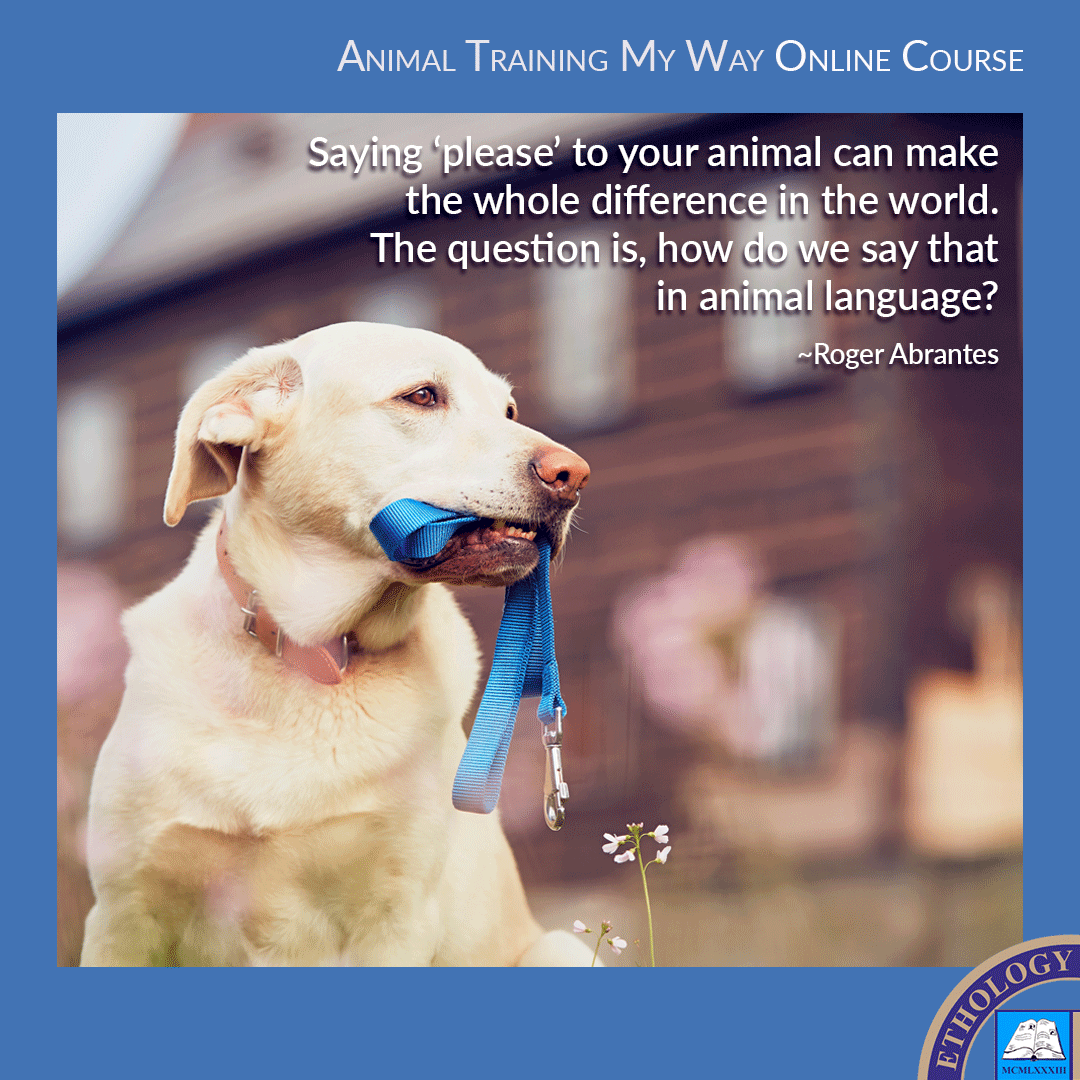Saying ‘please’ to your animal can make the whole difference between success and failure. The question is, how do we say that in animal language?
Simplicity is a virtue in life as well as in science and communication. We should always keep that in mind as our animal training gets going.
We can argue for using the dog’s name because it is the simplest signal for us; consequently, we should give the dog a simple and short name. “Adventurous Beautiful Sunset Over the Hills” is undoubtedly a poetic name with its grace if you are inclined to this kind of verse. It looks good in a pedigree but far too complicated for any practical use. It is harder to remember, than a nickname like ‘Bongo,’ it takes longer to pronounce, and it is more difficult to perceive in less than favorable environments. Human nicknames exist for the same reason.
The simplicity of signals is a principle we must always remember when we plan the training of an animal. All signals must have simple forms, no matter whether they are acoustic, visual or tactile.
Imagine we are in the same room and consider the following example. I tell you, “please, come here.” My goal (the objective of my signal) is to have you to move to where I am. ‘Come’ means, “move or travel toward or into a place thought of as near or familiar to the speaker,” or in simpler words, “move to me.”
The addition of ‘here’ is superfluous. ‘Here’ is where I am. If I did not want you to come to where I am, I would not say, ‘come,’ I would say ‘go.’
‘Please’ is in a sense also superfluous. It does not add anything to the behavior you must perform. We use it as a matter of convention because we lost some of our ability to communicate by other than verbal signals. I say, ‘please’ to set you in the right emotional frame of mind to comply with my signal, but I could do that as well without using it. If I said to you, ‘come’ with a smile on my face, a twinkle in my eye and a gentle tone in my voice, I would achieve the same and maybe even better.
“Please” in animal language is not a question of words.
Even though it is undoubtedly easier, if arguably poorer, to use common words to elicit emotions in our human interactions, it is impossible to accomplish the same when communicating with an animal. There is no way we can explain to an animal what we want to achieve with ‘please.’
Featured Course of the Week
Ethology and Behaviorism Ethology and Behaviorism explains and teaches you how to create reliable relationships with any animal. It is an innovative, yet simple and efficient approach created by ethologist Roger Abrantes.
Featured Price: € 168.00 € 98.00

When communicating with an animal, we are better off by just using ‘come’ instead of “please, come here.” It is simpler and conveys to the animal all it needs to know. We can also use ‘here.’ It has the same qualities and none of the mentioned disadvantages. The emotional function of ‘please’ in animal language is better substituted by a friendly body language, facial expression, and tone of voice, which social animals easily detect. ‘Please’ might also influence your state of mind—you are friendlier when you say ‘please’ than when you do not—but here you must compromise with the animal’s innate characteristics. Animals understand better a bodily or tonal ‘please’ than a verbal one, which they may miss altogether.
There are situations when we need not use ‘please’ and others where we achieve better our goal without it; the same goes for our communication with animals. Sometimes, we will need to use a more assertive body language, facial expression, and tonal voice to achieve our goal; and other times we need to be very assertive.
We must assess any particular situation and decide how to modulate our signals. There are two elements in a signal: (1) the factual, which is an operant controlled by the consequences and (2) the emotional, which is the respondent and which the signal itself elicits. It is our job to control both so we achieve the desired goal, and there is no magical formula to do so.
The factual part of it is clear. We only have to know the science behind it and comply with its rules. It is the part you can learn in the course “Animal Training My Way–Merging Ethology and Behaviorism.” The emotional part, which deals with empathy, is a difficult one. Either you have it, or you don’t. You may acquire it through experience, or you may not, and no one can help you with that.
This article is an excerpt from Roger Abrantes’ book, “Animal Training My Way—Merging Ethology and Behaviorism,” included in the course “Ethology and Behaviorism.“
Learn more in our course Ethology and Behaviorism. Based on Roger Abrantes’ book “Animal Training My Way—The Merging of Ethology and Behaviorism,” this online course explains and teaches you how to create a stable and balanced relationship with any animal. It analyses the way we interact with our animals, combines the best of ethology and behaviorism and comes up with an innovative, yet simple and efficient approach to animal training. A state-of-the-art online course in four lessons including videos, a beautiful flip-pages book, and quizzes.

